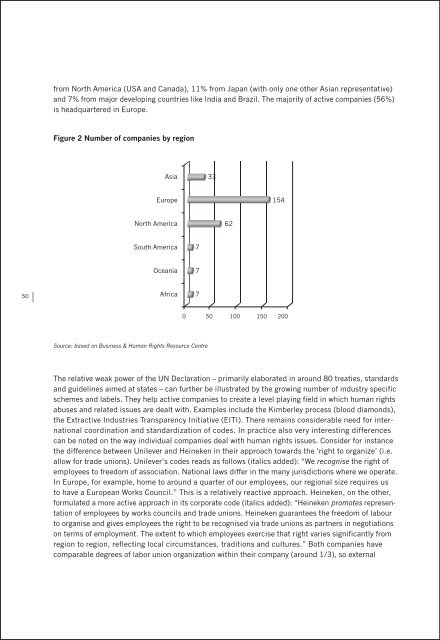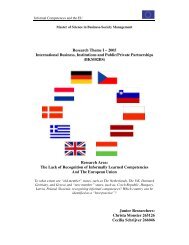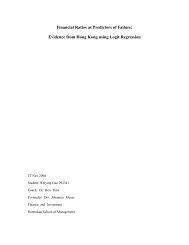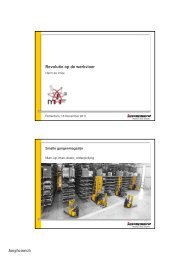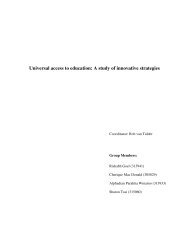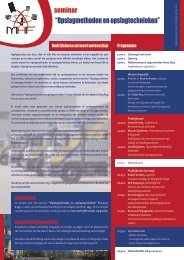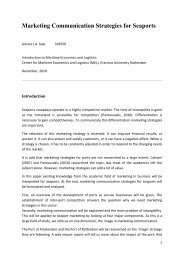Download With great power comes great responsibility (pdf) - ERIM
Download With great power comes great responsibility (pdf) - ERIM
Download With great power comes great responsibility (pdf) - ERIM
Create successful ePaper yourself
Turn your PDF publications into a flip-book with our unique Google optimized e-Paper software.
50<br />
from North America (USA and Canada), 11% from Japan (with only one other Asian representative)<br />
and 7% from major developing countries like India and Brazil. The majority of active companies (56%)<br />
is headquartered in Europe.<br />
Figure 2 Number of companies by region<br />
Asia<br />
Europe<br />
North America<br />
South America<br />
Oceania<br />
Africa<br />
Source: based on Business & Human Rights Resource Centre<br />
7<br />
7<br />
7<br />
33<br />
62<br />
The relative weak <strong>power</strong> of the UN Declaration – primarily elaborated in around 80 treaties, standards<br />
and guidelines aimed at states – can further be illustrated by the growing number of industry specific<br />
schemes and labels. They help active companies to create a level playing field in which human rights<br />
abuses and related issues are dealt with. Examples include the Kimberley process (blood diamonds),<br />
the Extractive Industries Transparency Initiative (EITI). There remains considerable need for inter -<br />
national coordination and standardization of codes. In practice also very interesting differences<br />
can be noted on the way individual companies deal with human rights issues. Consider for instance<br />
the difference between Unilever and Heineken in their approach towards the ‘right to organize’ (i.e.<br />
allow for trade unions). Unilever’s codes reads as follows (italics added): “We recognise the right of<br />
employees to freedom of association. National laws differ in the many jurisdictions where we operate.<br />
In Europe, for example, home to around a quarter of our employees, our regional size requires us<br />
to have a European Works Council.” This is a relatively reactive approach. Heineken, on the other,<br />
formulated a more active approach in its corporate code (italics added): “Heineken promotes represen -<br />
tation of employees by works councils and trade unions. Heineken guarantees the freedom of labour<br />
to organise and gives employees the right to be recognised via trade unions as partners in negotiations<br />
on terms of employment. The extent to which employees exercise that right varies significantly from<br />
region to region, reflecting local circumstances, traditions and cultures.” Both companies have<br />
comparable degrees of labor union organization within their company (around 1/3), so external<br />
154<br />
0 50 100 150 200<br />
influences can be considered more or less the same. The difference of approach can largely be<br />
attributed to the business models chosen (and related to that the intrinsic motivations of managers<br />
probably). In the case of Unilever: unit branding, multi-domestic, decentralised; in the case of<br />
Heineken: corporate branding, global, centralised.<br />
5.3 Meaningful Reporting<br />
Individual companies have increasingly started to report on human rights in order to address the<br />
accountability gap. The current Human Rights Performance Indicators in the GRI G3 Guidelines<br />
require organisations to report on the extent to which human rights are considered in investment<br />
and supplier / contractor selection practices. Additionally, the Indicators cover employee and security<br />
forces training on human rights as well as non-discrimination, freedom of association, child labor,<br />
indigenous rights, and forced and compulsory labor. The Global Reporting Initiative and the Roberts<br />
Environmental Center (a research institute at Claremont McKenna College) conducted a survey of<br />
corporate human rights reporting based on information published by 100 large companies from<br />
around the world. 10 The survey focused on evaluating the extent to which performance information is<br />
reported by companies to describe their compliance with widely accepted human rights objectives.<br />
In particular, compliance with the GRI G3 Sustainability Reporting Guidelines on human rights was<br />
assessed. In addition, information was compiled on the range of topics dealt with as human rights,<br />
the kinds of information reported, and the organizational structure of reporting. Most often human<br />
rights topics were included in the social section of sustainability reports, but they were not necessarily<br />
identified as human rights. The most frequently addressed topics had to do with labor practices which<br />
were often presented in report sections about labor without identifying them as human rights. Almost<br />
all topics identified by companies as human rights are covered in the G3 Guidelines, but not necessarily<br />
under the category called human rights. When the nine topics addressed by the G3 human rights<br />
indicators were searched for in company reports, four were not mentioned at all by half or more of<br />
the surveyed companies.<br />
The four labor related topics were the most frequently reported, with screening of the supply chain for<br />
human rights compliance also addressed by more than half of the samples. When strict compliance<br />
with quantitative G3 Human Rights Performance Indicators was examined, fully conforming reporting<br />
was found in only 7% of possible cases for companies who declared use of G3 Guidelines and 2% for<br />
other companies. An index showing depth of reporting was devised to measure reporting of policy,<br />
actions, and performance. Only 13 companies scored at or above the median of possible scores, and<br />
it was common for policy or action information to be reported rather than performance. In an exami -<br />
nation of performance reporting alone, it was found that quantitative information about performance<br />
was provided in 9% of possible cases, which was slightly over half of the time that any performance<br />
information was reported. G3 declared companies reported human rights performance information<br />
quantitatively in only 13% of possible cases, but this was roughly three times as often as other<br />
companies. So, the survey showed that labor practices are the most widely reported human rights<br />
topics but they are often not identified by reporters as human rights. An explanation for this is because<br />
companies still consider human rights as to sensitive politically. Even with labor practices counted,<br />
very little company reporting about human rights provides quantitative performance information.<br />
Although strict adherence to G3 Human Rights Performance Indicators is very low, G3 declared<br />
companies report quantitative performance information more often than other companies.<br />
10) “Reporting on Human Rights”: http://www.globalreporting.org/NR/rdonlyres/13865428-9EAC-4EB0-A8E3-A31AA2F5C38C/3469/ -<br />
HRReportFinal.<strong>pdf</strong><br />
51


